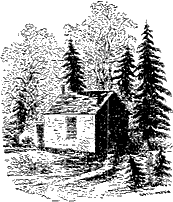
Drawing of Thoreau's cabin by his sister Sophia
Lesson 1: The life and times of Thoreau
Lesson 2: Thoreau's philosophy of government
Lesson 3: Thoreau's writing style
Lesson 4: Imprisonment and individuality
Lesson 1: How can we better understand Henry David Thoreau's philosophy in the context of his life and times?
Instructional Objectives: Students will be able to research and report on the life and times of Henry David Thoreau; to use the Internet to collaboratively locate information; and to present the results of their research.
Time: Two 40-minute class periods
Motivation: Go to http://nanosft.com/walden/october/inside.html or look at a print copy of a photo of Thoreau's house. Direct students to freewrite (just write what comes to mind without concern for style, grammar, etc.) for a few minutes on, "What this room tells you about the person who lived there."
After three minutes or so, ask students to finish their remarks. Then ask them to share their impressions Expressions of simple, poor, old, will probably be elicited.
The teacher may make a few comments at this time on Thoreau's life alone on Walden Pond as part of his philosophy to live in harmony with nature. One of Thoreau's most oft-cited quotes may be shared with the class:
"I went to the woods because I wished to live deliberately, to front only the essential facts of life, and see if I could not learn what it had to teach, and not, when I came to die, discover that I had not lived."
| Web
resources for background information on Thoreau:
The Writings of Henry D. Thoreau, Northern Illinois University: http://thoreau.niu.edu/index.html Thoreau, Walden, and the Environment http://walden.org A Reading Group/Discussion Guide to Walden; the Beacon Press Edition: http://beacon.org/readguide/rgwalden.html
|
Development: Students will work in cooperative groups to research and report to the class on the following topics related to Thoreau's life and times. An understanding of this time period and major political events is critical before students can read and effectively analyze "Civil Disobedience."
| Biography of H.D. Thoreau | The Fugitive Slave Act | Ralph Waldo Emerson |
| The Mexican-American War | Transcendentalism | Brook Farm, West Roxbury, MA |
Note: All links were active as of January 2003; please review before assigning to your class. Adjustments may also need to be made based on your students' reading level.
*Click here for student instructions*Click here for answer key
Summary: Each group will present its findings to the class in either the form of a PowerPoint presentation (if time and technology skills allow) or as a web page, posterboard, transparency, etc.
Homework: Each student will write a unified, cohesive paragraph on his or her research topic.
Evaluation: Student performance will be assessed according to accuracy and breadth of information presented; attention to conventions of English grammar and style; and teacher observation of individual participation in groups.
After the group presentations each student will take this online quiz: http://school.discovery.com/quizzes26/cbhuck/HenryDavidThoreau.html
Extension: As a creative arts activity, this web site has a free, downloadable card model of Thoreau's cabin (a .pdf file). There is also an interactive model that can be clicked for Thoreau's thoughts on various items, such as the fireplace, wood pile, furniture, and more. http://fiddlersgreen.net/buildings/new-england/thoreau/cabin.htm